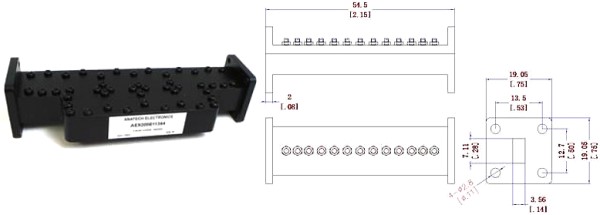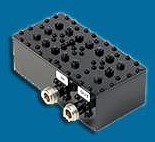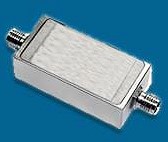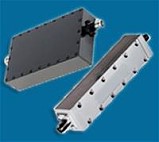
Press Release Archives:
2025 |
2024 |
2023 |
2022 |
2021
2020 |
2019
Content is copyright of company represented. Page format, custom text and
images are RF Cafe copyright - do not distribute. Note: Beginning
March 2025, posting of press releases will cost $100 each for non-advertisers.

Sam Benzacar of Anatech Electronics, an RF and microwave filter company, has
published his October newsletter that features his short op-ed entitled
"Coming: Plasma Antennas." Plasma antennas have been appearing in the news items
I collect, and Sam does a pretty good job summarizing their operation and
benefits. One feature I do not recall seeing elsewhere is that in the "off"
state, the plasma antenna presents a very small radar cross section (RCS), which
is strategically advantageous for stealth aircraft (and surface ships).
In other news, Sam includes other news related to our RF industry.
A Word from Sam Benzacar
 Coming:
Plasma Antennas
By Sam Benzacar
If you think there cannot possibly be any radically new antennas in the works,
you'll be surprised to learn, as I did, that there are, and one of the most "far
out" is the plasma antenna. The name alone connotes something more likely to be
found on the Starship Enterprise, but plasma antennas are real - and impressive.
Gases are typically insulators and not conductive. However, when they're exposed
to heat or electromagnetic energy a plasma is created through ionization in which
atoms are converted to ions and electrons. In contrast to its former state, a plasma
is conductive which provides its appeal for use with systems operating in the electromagnetic
spectrum, including antennas. A plasma antenna can perform the same functions as
conventional array antennas with fewer components and at lower cost, including steering
and beamforming, have demonstrated operation at millimeter-wave frequencies, and
can handle a considerable amount of RF power.
 What sets a plasma antenna even further apart
from any other type is that when it's turned off it becomes nearly invisible, making
it extremely difficult to detect by radar, as its radar cross section essentially
consists of just the material in which the plasma is contained, such as glass. That
is, when the energy source is removed the plasma becomes a neutral non-conductive
gas, a process that takes just milliseconds. Plasma antennas can also have low side
lobes that further decrease their likelihood of being jammed. The technology has
other benefits as well. What sets a plasma antenna even further apart
from any other type is that when it's turned off it becomes nearly invisible, making
it extremely difficult to detect by radar, as its radar cross section essentially
consists of just the material in which the plasma is contained, such as glass. That
is, when the energy source is removed the plasma becomes a neutral non-conductive
gas, a process that takes just milliseconds. Plasma antennas can also have low side
lobes that further decrease their likelihood of being jammed. The technology has
other benefits as well.
There are two basic types of plasma antennas, semiconductor and gaseous, the
former the first to be developed (but still valid) and the latter recent fabricated
using silicon fabrication processes to create what's called a plasma silicon antenna
(PsiAN). This device consists of huge numbers of diodes that when activated individually
generate a cloud of electrons, forming a plasma.
Each cloud reflects RF energy like a mirror and if the diodes are selectively
activated the shape of this "reflector" can be changed rapidly to focus and steer
a beam. The antennas are very small, at 28 GHz measuring about 10 mm in diameter
and 4 mm at 60 GHz and produce very high forward gain. If lower gain can be accommodated
the antenna can be radiated directly by the chip. Several companies are developing
this technology and have commercialized their designs, and as DoD is obviously extremely
interested in plasma antennas it's likely we'll be hearing about them a lot more
in the future.
 FCC OKs
CBRS Deployments FCC OKs
CBRS Deployments
The FCC has approved the Spectrum Access Systems (SASs) operated by Google, Federated
Wireless, CommScope, Amdocs, and Sony for managing Citizens Broadband Radio Service
(CBRS) networks. CBRS is the Next Big Band for wireless carriers, Wireless Internet
Service Providers (WISPs), private LTE networks, and cable operators looking to
deploy their own cellular services. In addition, there are many other possible use
cases for the band, as it offers a tiered structure consisting of licensed and unlicensed
operators. As the SAS is the essential element for managing CBRS devices to keep
them from interfering with Navy radar systems, the FCC approval is a major step
forward.
 Microwave Energy for Plastic Recycling Microwave Energy for Plastic Recycling
A European research project is testing a way to make recycling PET plastic (used
to make packaging, soda bottles, and clothing) more effective by combining microwave
technology with a chemical reaction. The degradation of PET is called depolymerization
and the first step in the process uses microwave energy to convert PET waste into
hydrolyzed plastic. The plastic is then separated from other materials, which allows
them to be renewed for further use. This is done using a complicated purification
process. The project is funded by the EU's Horizon 2020 program.
 A Microwave
Weed Killer A Microwave
Weed Killer
University of Melbourne researcher Dr. Graham Brodie has invented a device that
uses microwave energy to control weeds, reducing the need for herbicides. By using
microwave energy to heat the water particles within a weed, the vibrations cause
the plant cell walls to explode, killing the plant. But the challenge is to translate
the concept into a product that can work in the field over large areas without using
too much energy.
To meet that challenge, Brodie has designed an antenna that can effectively deliver
microwave energy specifically into the weeds, as well as into the ground itself
to pre-treat soil before crops are sown. The technology reportedly not only kills
weeds but also eliminates dormant seeds, according to Brodie, who has spent the
last 5 years improving his invention, testing it on more than 25 species of weed
including ryegrass, barnyard grass, bellyache bush, hemlock, wild radish, wild oats,
and fleabane.
The antenna confines the microwave energy closely to the surface of the ground,
and as the system is modular it can attach to tractors. The product has been commercialized
with investment from Grains Research & Development Corporation, resulting in
a company called GroWave.
 Air Force Develops THOR to Kill Drones Air Force Develops THOR to Kill Drones
The Air Force Research Laboratory recently demonstrated an electromagnetic weapon
called the Tactical High-power Operational Responder (THOR) designed to disable
drones. It was shown at the recent Air Force Association Air, Space, and Cyber Conference,
and has been built and tested on military test ranges near Kirtland AFB, where it
has successfully engaged multiple targets. Further testing against a larger set
of drone types in swarming configurations is planned.
THOR could be useful in attacks like those on Saudi oil fields in which multiple
drones of different sizes made it possible for the larger ones to shadow the smaller
ones, protecting them from radar detection. THOR stores in a 20-foot transport container
that can be transported in a C-130 and can be set up in 3 hours, according to AFRL.
THOR cost about $15 million to develop
Getting Ready for 5G:
Anatech Electronics introduce New Ka band 30.5 GHz Waveguide Band Pass Filter.
Featuring a center frequency of 30.5 GHz, a bandwidth of 1000 MHz, an Insertion
Loss 1 dB Max, and a Power Handling is 20 watts.

Anatech Electronics Introduces a New Line of Suspended Stripline and
Waveguide Type RF Filters
Check out Our Filter Products



Cavity Band Pass Filters
LC Band Pass Filters Cavity Bandstop/Notch Filter
About Anatech Electronics
Anatech Electronics, Inc. (AEI) specializes in the design and manufacture of
standard and custom RF and microwave filters and other passive components and subsystems
employed in commercial, industrial, and aerospace and applications. Products are
available from an operating frequency range of 10 kHz to 30 GHz and include cavity,
ceramic, crystal, LC, and surface acoustic wave (SAW), as well as power combiners/dividers,
duplexers and diplexers, directional couplers, terminations, attenuators, circulators,
EMI filters, and lightning arrestors. The company's custom products and capabilities
are available at www.anatechelectronics.com.
Contact:
Anatech Electronics, Inc. 70 Outwater Lane Garfield, NJ 07026 (973)
772-4242
sales@anatechelectronics.com
Posted October 17, 2019
|









 What sets a plasma antenna even further apart
from any other type is that when it's turned off it becomes nearly invisible, making
it extremely difficult to detect by radar, as its radar cross section essentially
consists of just the material in which the plasma is contained, such as glass. That
is, when the energy source is removed the plasma becomes a neutral non-conductive
gas, a process that takes just milliseconds. Plasma antennas can also have low side
lobes that further decrease their likelihood of being jammed. The technology has
other benefits as well.
What sets a plasma antenna even further apart
from any other type is that when it's turned off it becomes nearly invisible, making
it extremely difficult to detect by radar, as its radar cross section essentially
consists of just the material in which the plasma is contained, such as glass. That
is, when the energy source is removed the plasma becomes a neutral non-conductive
gas, a process that takes just milliseconds. Plasma antennas can also have low side
lobes that further decrease their likelihood of being jammed. The technology has
other benefits as well.  FCC OKs
CBRS Deployments
FCC OKs
CBRS Deployments Microwave Energy for Plastic Recycling
Microwave Energy for Plastic Recycling A Microwave
Weed Killer
A Microwave
Weed Killer Air Force Develops THOR to Kill Drones
Air Force Develops THOR to Kill Drones





